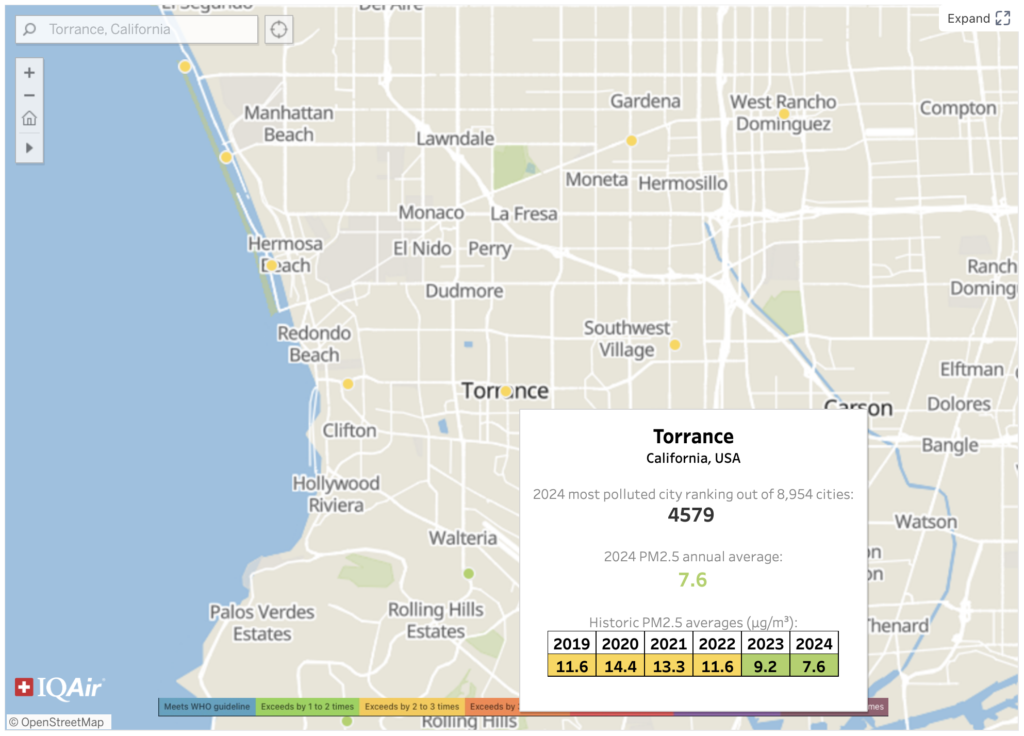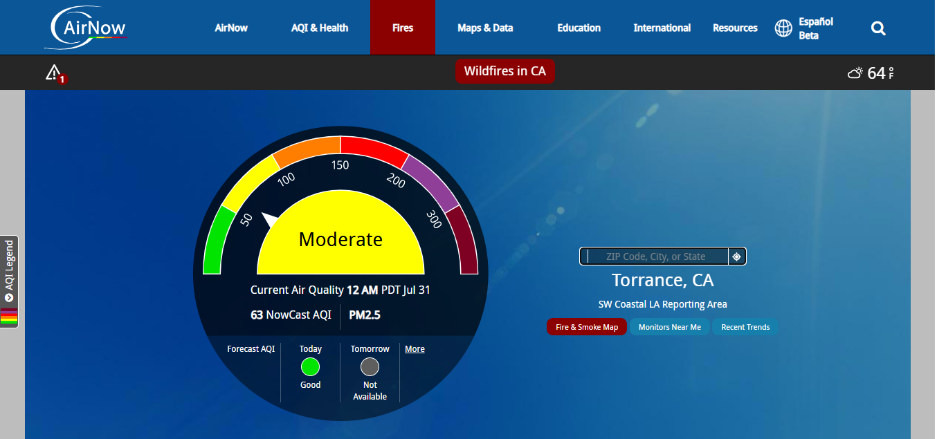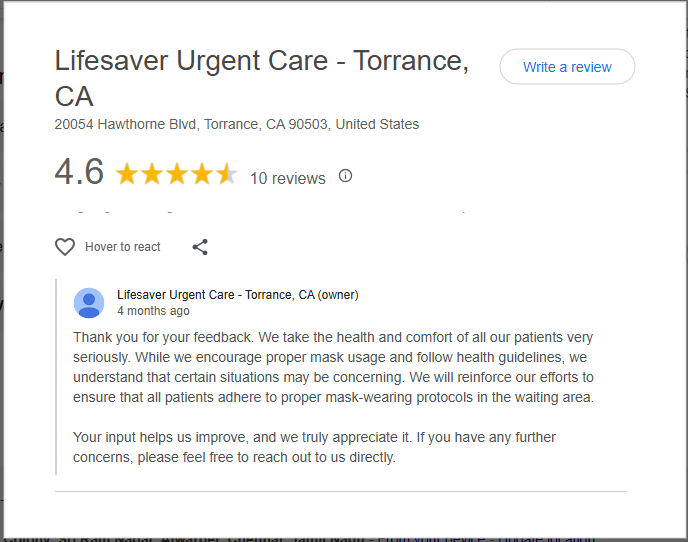Table of Contents
ToggleThe Rise of Wildfire Smoke Threats in Torrance

These particles can penetrate deep into the lungs, aggravating asthma, COPD, and other respiratory issues. Torrance residents, especially the elderly, children, and those with pre-existing lung conditions are increasingly vulnerable.
Healthcare providers in Torrance are seeing a spike in urgent care visits related to smoke-induced symptoms: coughing, wheezing, eye irritation, and even anxiety triggered by breathing difficulties. Urgent Care in Torrance, local providers have reported seasonal uptick in patients needing immediate attention for respiratory complaints.
The bigger concern?
Wildfire smoke doesn’t just affect the air quality it also affects behavior. Residents reduce outdoor activity, elderly individuals may be unable to evacuate, and children miss school. The city’s infrastructure is being tested, prompting discussions around better preparedness and accessible healthcare.
To protect against this growing threat, residents are advised to:
- Monitor the Air Quality Index (AQI)
- Use HEPA filters indoors.
Limit outdoor activity during high AQI days.

Understanding Wildfire Smoke: What It’s Made Of
Wildfire smoke is more than just a hazy nuisance; it’s a complex mixture of harmful pollutants. It contains fine particulate matter (PM2.5), carbon monoxide, volatile organic compounds (VOCs), and trace metals released from burning vegetation, homes, and synthetic materials. PM2.5 particles are especially dangerous as they can enter deep into the lungs and even the bloodstream. The composition can vary depending on what’s burning, but the health risks remain high, especially with prolonged exposure.
Now that we know what wildfire smoke is made of, let’s explore how it affects our bodies, especially the lungs, heart, and immune system
Health Impacts of Wildfire Smoke
Torrance, California, has increasingly found itself under smoky skies during wildfire season. While the visual effects are apparent, the invisible toll wildfire smoke takes on public health is alarming. From breathing difficulties to long-term cardiovascular stress, the danger lies in what you can’t see—tiny particles and gases that quietly disrupt your body’s vital systems.
The Silent Danger: PM2.5 and Its Effects
The most harmful component in wildfire smoke is PM2.5, particulate matter with a diameter of 2.5 micrometers or less. These microscopic particles can bypass your body’s natural filters, lodging deep within your lungs and even entering the bloodstream.
According to the EPA, exposure to PM2.5 can lead to:
- Aggravated asthma
- Chronic bronchitis
- Reduced lung function
- Increased hospital admissions for heart and lung conditions
Respiratory Issues on the Rise
The lungs are the first line of defense and the first to suffer. People with pre-existing conditions like asthma, COPD, or allergies experience more frequent flare-ups during smoke events. Even healthy individuals may notice:
- Persistent coughing
- Shortness of breath
- Wheezing
- Sore throat
Children and seniors are especially vulnerable, as their respiratory systems are either still developing or already weakened. In fact, studies show that emergency room visits for respiratory issues can spike by up to 42% on heavy smoke days.
Cardiovascular Strain: The Hidden Risk
Beyond the lungs, PM2.5 particles have a direct impact on heart health. These particles can enter the bloodstream and trigger inflammation in blood vessels, leading to:
- Elevated blood pressure
- Increased risk of heart attacks
- Arrhythmias (irregular heartbeats)
- Stroke
People with hypertension or heart disease are at higher risk. According to the American Heart Association, even short-term exposure to wildfire smoke can increase the risk of cardiac events by up to 70% in vulnerable populations.
Cognitive and Mental Health Effects
Wildfire smoke doesn’t just affect the body it can also cloud the mind. Prolonged exposure to poor air quality has been linked to:
- Cognitive decline
- Increased risk of dementia
- Mood disorders such as anxiety and depression
Researchers at UC Davis found that neuroinflammation can be triggered by particulate matter, which may affect brain health over time. This is especially a concern in children and the elderly, whose brains are either forming or already declining.
5. Eye, Nose, and Skin Irritation
Irritation from smoke exposure isn’t limited to the internal organs. Short-term effects often include:
- Burning eyes
- Nasal congestion
- Dry or itchy skin
These symptoms may seem minor but can lead to infections or more serious complications if not addressed, especially among those with sensitive skin or allergies.
Long-Term Exposure Risks
Chronic exposure to wildfire smoke—over multiple seasons or years—can contribute to:
- Reduced lung growth in children
- Increased risk of lung cancer
- Permanent damage to alveoli (air sacs in lungs)
- Systemic inflammation linked to autoimmune disorders
A 2023 study published in The Lancet projected that the long-term health cost of wildfire-related air pollution could exceed $190 billion annually in the U.S. alone.
Who’s Most at Risk from Wildfire Smoke Exposure?
Wildfire smoke contains harmful pollutants that can affect anyone’s health, but some groups face significantly higher risks. Understanding who is most vulnerable helps communities like Torrance prepare and protect these populations effectively.
Children Under 12
Children’s lungs and immune systems are still developing, making them more susceptible to airborne toxins.
According to the American Lung Association, children exposed to high levels of particulate matter (PM2.5) have increased risks of developing asthma and other chronic respiratory conditions.
Studies show that during wildfire events, emergency room visits for respiratory issues among children can rise by up to 30-40%.
Kids are more active outdoors and tend to breathe faster than adults, increasing their pollutant intake.
Seniors Aged 65 and Above
Older adults often have diminished lung capacity and may suffer from chronic conditions like COPD, heart disease, or diabetes, which wildfire smoke can exacerbate.
Research from the Centers for Disease Control and Prevention (CDC) indicates that seniors are more likely to be hospitalized or have severe complications during smoke exposure events.
Mortality rates linked to poor air quality rise sharply in this age group, with studies estimating a 15-20% increase in cardiovascular and respiratory-related deaths during wildfire seasons.
Outdoor Workers (Delivery, Landscaping, Utility)
Workers who spend extended periods outdoors are exposed to wildfire pollutants for longer durations and at higher concentrations.
The California Department of Public Health advises outdoor workers to take extra precautions during wildfire smoke events, including wearing N95 masks and limiting strenuous activity.
Data shows that these workers have a higher incidence of respiratory symptoms, such as coughing and wheezing, and are at risk of heat-related illnesses compounded by poor air quality.
Many outdoor workers also face economic pressure to continue working despite hazardous conditions, increasing health risks.
People With Pre-Existing Respiratory or Heart Conditions
Individuals with asthma, COPD, bronchitis, or cardiovascular disease are more vulnerable to wildfire smoke’s adverse effects.
Exposure can trigger asthma attacks, COPD exacerbations, arrhythmias, and even heart attacks.
The American Heart Association reports that wildfire smoke exposure increases the risk of cardiovascular events by up to 70% in these populations.
Timely medical intervention and preventive care during wildfire seasons are critical to reduce hospitalizations and long-term damage.
Preventing Injuries & Respiratory Issues During Wildfire Smoke Exposure
- Wildfire smoke poses serious health risks, but many can be minimized with simple precautions. In Torrance, where air quality often dips into the unhealthy range during fire season, residents should stay vigilant to protect themselves and their families.
- Stay indoors when the Air Quality Index (AQI) reaches 151 or higher, classified as “Unhealthy.” Limiting outdoor exposure reduces inhalation of fine particulate matter (PM2.5), which can penetrate deep into the lungs.
- When venturing outside, wear an N95 respirator mask instead of cloth or surgical masks. N95s filter out at least 95% of airborne particles and provide much-needed protection against smoke pollutants.
- Hydration is key. Drinking plenty of water helps keep mucus membranes moist, reducing irritation in the eyes, nose, and throat caused by smoke. This also supports the body’s natural ability to clear inhaled toxins.
- Using indoor air purifiers equipped with HEPA filters can significantly improve air quality inside your home. These filters trap fine particles and allergens, creating a safer breathing environment.
- Be cautious of slip hazards indoors and outdoors, as soot from smoke can accumulate on floors and shoes, increasing the risk of falls and minor injuries during evacuations or hurried movements.
When to Seek Urgent Care
You should visit urgent care if you experience:
- Shortness of breath
- Persistent cough or wheezing
- Burning eyes, throat, or chest
- Dizziness or fainting
- Minor falls or sprains from rushed evacuation
Per California’s Timely Access to Care Law, patients must be seen by an urgent care provider within 48 hours
Minor Injury Rehab Services During Fire Season
Case in point: a resident injures their ankle during a rushed evacuation. Instead of waiting weeks for a PT appointment, they can:
- Get initial diagnosis and X-ray
- Receive a splint or brace
- Begin mild rehab within 2 days
- Schedule follow-ups for re-evaluation
Life Saver Urgent Care provides walk-in rehab services ideal for such scenarios.
How Life Saver Urgent Care Supports Torrance Residents
Life Saver Urgent Care in Torrance offers:
- Same-day respiratory exams
- Minor injury and rehab treatment
- Nebulizer therapy for asthma/COPD
- Pediatric and geriatric-friendly care
- Coordination with nearby specialists if hospitalization is needed
Insurance, Access, and Extended Hours
Accepted insurance includes Blue Shield, Anthem, Aetna, and Medicare. Open 6 days a week Monday to Saturday from 9 am to 6 pm, Life Saver is strategically located near schools, community centers, and bus stops.
Local Emergency Preparedness & Evacuation Trends
Torrance Fire Department’s 2023 Wildfire Evacuation Drill showed:
- 40% of residents didn’t know where to go
- 18% suffered minor injuries while moving quickly
- Only 12% had go-bags ready with meds and masks
Urgent care plays a vital role when ERs are overburdened during such events.
Air Quality Apps, Alerts, and Community Response
Residents are encouraged to download:
These offer real-time AQI updates and evacuation advisories.
Patient Testimonial: Quick Recovery After a Fall
“I slipped trying to get our dog into the car during the Palos Verdes fire. Urgent care specialists got me in, X-rayed my knee, gave me a brace, and even showed me exercises. I was walking again in 3 days.” – Maria, 57, Torrance.

Your Rights: Timely Access to Care Under California Law
Under DMHC’s patient rights:
- You are entitled to urgent care within 48 hours
- No referral is needed for urgent care visits
- You can appeal delays or denials via DMHC
Be Prepared, Stay Informed
Keep Life Saver Urgent Care on your speed dial. During wildfire season, timely care isn’t just convenient, it can be life saving. Stay hydrated, monitor air quality, prep go-bags, and know where to go if symptoms or injuries arise.
Visit Life Saver Urgent Care in Torrance for fast, reliable, and compassionate care when it matters most.
FAQ’s
Wildfire smoke in Torrance can trigger respiratory issues like asthma attacks, bronchitis, and COPD flare-ups. It also increases the risk of eye irritation, cardiovascular stress, and fatigue, especially among children, seniors, and outdoor workers.
Visit urgent care if you experience symptoms like shortness of breath, wheezing, a persistent cough, chest tightness, burning eyes, dizziness, or minor injuries from evacuation efforts. Immediate care helps prevent complications and ensures faster recovery.
Yes. Urgent care centers provide quick assessment, X-rays, braces, and light rehab for ankle sprains, minor fractures, and soft tissue injuries that often occur during hasty evacuations or poor visibility conditions.
Absolutely. Even healthy individuals can suffer from throat irritation, headaches, and reduced lung function due to fine particulate matter (PM2.5) in wildfire smoke. Prolonged exposure can lead to long-term respiratory issues if left unmanaged.
Stay indoors on high AQI days, wear N95 masks outdoors, use air purifiers with HEPA filters, hydrate well, and avoid physical exertion. Also, keep evacuation paths clear to prevent slip-and-fall injuries caused by soot buildup or clutter.
Under California’s Timely Access to Care Law, you must be offered an urgent care appointment within 48 hours of requesting care. Many centers, offer walk-in visits for faster service.
Use trusted apps like IQAir AirVisual, AirNow Mobile, and Alert SouthBay Torrance to receive real-time AQI updates, wildfire smoke alerts, and evacuation guidance specific to your neighborhood.




